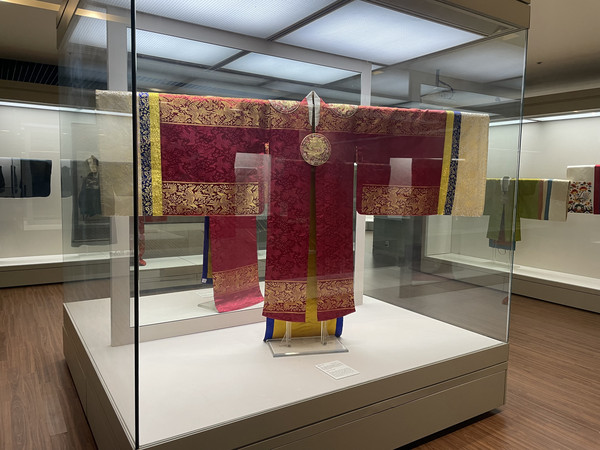
On October 16, the opening ceremony for the 20th anniversary special exhibition "Ceremonial Costumes of East Asia" was held at the Chung Young Yang Embroidery Museum, located in Sookmyung Women's University's Renaissance Plaza in the 2nd Foundation Campus. To begin, the MC introduced visitors such as ambassadors to Korea and the directors of several museums in Korea. Lee Kyung-sook, a former president of SMWU, was also in attendance and delivered the welcome address in front of the guests. Jang Yoon-geum, current president of SMWU, said, "My heart was beating as it was really an honor for me to have this celebration. I think it can show the dignity and history of SMWU. I am extremely grateful to Chung Young-yang for her great efforts for the museum." There was the unveiling of a copper plate which has a quotation of Chung Young-yang, saying, "Textile is not only a product of technology, but also a work of art, while embroidery is a form of expression that defines that period." Also, she talked about politeness, which is one of the purposes of ceremonial costumes that is related to the title of this special exhibition. She emphasized the importance of tradition in terms of propriety. After her speech, the attendees were free to look around the museum while hearing explanations before enjoying a reception. According to Park Hye-kyung, curator of the museum, this exhibition can be an opportunity to let the outside world know that many valuable artifacts related to textiles of East Asia are on display at SMWU. Furthermore, an attendee of the ceremony and alumna of SMWU, Kim Eun-sook, Department of Clothing & Textiles '95, said "The fact that our university has such a comprehensive embroidery museum makes me proud and I think Chung Young-yang, the director, has a great eye in regard to the collection. It is meaningful that we can see the embroidery of not only Korea but also East Asia in one place." The whole process of celebrating the preservation of embroidery in this museum for 20 years and the beginning of a new exhibition provided a chance to feel that it is precious to explore the aesthetic works of embroidery to visitors.
The special exhibition, which launched with the opening ceremony, will be on display from October 16 to December 29. It focuses on the clothing used for ceremonies in the East Asian countries of Korea, China, and Japan, and their embroidery. Among the various ceremonies, Gwanhonsangje, which means the four ceremonial occasions of coming of age, wedding, funeral, and ancestral rites, are a common tradition in Confucian cultures, and the clothing used to perform these rituals has been passed down through generations. In particular, marriage ceremonies are presented as events that signify the formation of a family, and the traditional wedding clothes of each country are on display. The clothes are spread out on a large scale so that students can observe the shapes and the patterns of the embroidery in detail. This helps students to clearly see the crane and pine tree, which symbolize longevity, on the traditional Japanese wedding dress, the "uchikake." There is also a section dedicated to embroidery. This section covers the historical development of embroidery, starting with primitive styles. According to the explanation, primitive embroidery was intended to represent a person's social status, position, and values. It was also used in religious rituals, such as conjury, and was often embroidered with related patterns. In its earliest form, it was characterized by simple patterns rather than complex ones. However, as societies evolved, so did the technology of weaving, allowing for more complex designs such as representations of phoenixes and dragons. Although the elaborateness and colorfulness of the patterns changed, the purpose of primitive embroidery to depict human life continued. This shows that embroidery serves as a form of visual language to convey people's lives and cultures. These embroideries were also applied to objects other than clothing. The folding screen in the center of this section is embroidered with flowers. This allows students to recognize that the visual and aesthetic sense of embroidery are applied in a variety of ways. The explanation also conveys the existence of "embroidery paintings," in which the embroidery is based on a painting by a famous artist. After visiting the exhibition, Park Min-A, Department of History & Culture '22, said, "I was already familiar with traditional clothing through various media, but I didn't know well about the embroidery on each garment and its meaning. Thanks to this exhibition, I was able to learn more about them." More information about the exhibition can be found on the Chung Young Yang Embroidery Museum's website, YouTube, and Instagram.
Jo Yoo Suyeon / Reporter
smt.jysy@gmail.com
Lee Park Jeongeun / Reporter
smt.lpje@gmail.com


